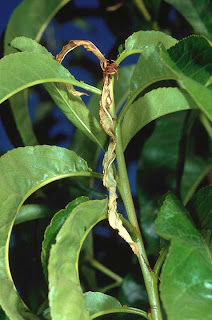Peach Twig Borer and May Spray Timing
Peach Twig Borer (Anarsia lineatella) (PTB) is a long time pest of almonds, being first reported in California in the 1880s. It was considered to be the worst pest of almonds until the arrival of the Navel Orange Worm in the 1940s. Today, it still remains an important pest because of its direct damage to the nuts, damage and feeding on green and new shoots - killing terminal growth, and the preference of PTB damaged nuts by navel orange worm.
PTB can be found overwintering as a worm (larva) in a tiny cell (hibernaculum) within the crotches of one to three year old wood. They may also survive in pruning wounds and bark cracks. Larvae emerge around bloom and migrate up the twigs and branches where they tunnel inside the branch, killing the terminal shoot. This loss of terminal shoots and subsequent delay in growth can be very problematic for young orchards.
PTB adults begin to emerge around late March/ early April. Adults are gray in color and are about a 1/4 to a 1/2 inch in length. The adults lay eggs on twigs during May and June which give rise to the second flight of moths in Late June/Early July. Second generation moths then repeat the cycle, causing damage and laying another generation of eggs.
Nuts become more susceptible to damage as they near harvest. Feeding on green nuts by PTB makes them more attractive to NOW. Branch damage, although problematic on young trees, is not considered an issue on mature trees. Cultivars differ in their susceptibility to nut damage, Merced and Thompson are the most susceptible, followed by Nonpareil, Fritz, Price, and Ne Plus Ultra.
PTB has three different management options throughout the growing season. Dormant season applications can be made to kill the larvae overwintering in the hibernaculum, bloom time sprays can be made to kill the larva with insecticides that do not target bees, and May spray timing can be made to kill adult moths and their first generation of larvae and eggs. Hull split timing is not recommended due to the difficulty of timing.
Since we previously discussed different treatment options for the dormant and bloom period in a previous article, lets focus briefly on options for the "May Spray" timing. The May spray should be made 400-500 degree days after the first few moths are caught (biofix). To trap the first moths, pheromone traps should be placed in the orchard by the last week of March in order to catch the first emerging adults. Once the first few moths are caught, degree day accumulation begins. To make calculating degree days easier, the UC IPM website has developed a day degree calculator based upon a CIMIS weather station in proximity to your farm.
Timing for the "May Spray" PTB usually occurs in early to mid May - hence "May Spray." This year, biofixes were later than normal, due to the cool weather and its effect on insect development. This week, many orchards are approaching 500 DD. Applications of either Spinetoram (Delegate), Chlorantraniliprole (Altacor), Flubendiamide (Belt), Methoxyfenozide (Intrepid), Spinosad (Entrust, Success), Phosmet (Imidan), Esfenvalerate (Asana XL), and Bacillus thuringiensis (BT) can be made to target moths, larvae, and eggs. Broad spectrums such as phosmet and esfenvalerate will kill non-targetted pests possibly causing flare ups and/or have drift, water, and environmental concerns. Bt provides an organic option for PTB control. Please see UC IPM for more information and rates.
Mating disruption has been shown to work, but have not provided reliable control when used alone. Future development of technologies will hopefully improve the efficacy of mating disruption. Bio-control does help reduce the population, but treatments are usually still needed in most orchards.
So, now a question comes to mind: If there are three treatment options, which one is best? The answer depends on your familiarity of your orchard and products, timing of other sprays, and the need to control other insect pests. The dormant timing should be considered if another spray application is planned to be made (i.e. scale treatment). Applying a tank mix of fungicides and PTB specific insecticides can be made at bloom - and has been shown to be very effective. Spring spray timing often overlaps with NOW, providing great control for PTB and okay control for NOW. So, timing really depends on the problems that are specific to your orchard and your management strategies for the crop year.





